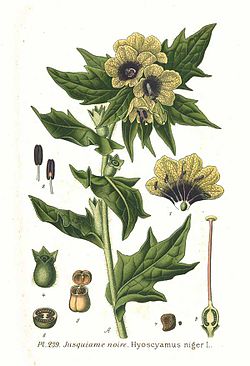This is an unofficial archive of PsychonautWiki as of 2025-08-08T03:33:20Z. Content on this page may be outdated, incomplete, or inaccurate. Please refer to the original page for the most up-to-date information.
Hyoscyamus niger (botany): Difference between revisions
Jump to navigation
Jump to search
>LockPicker m removed Category:Botany, Category:Plant |
>Graham m wiki ref formatting |
||
| Line 4: | Line 4: | ||
==Chemistry== | ==Chemistry== | ||
The leaves and herbage contain S-(–)-hyoscyamine and S-(–)-scopolamine. Trace amounts of aposcopolamine, not scopolamine, littorine, tropine, cuscohygrine, tigloidine, and tigloyloxytropane have also been found.<ref> | The leaves and herbage contain S-(–)-hyoscyamine and S-(–)-scopolamine. Trace amounts of aposcopolamine, not scopolamine, littorine, tropine, cuscohygrine, tigloidine, and tigloyloxytropane have also been found.<ref>{{cite book | vauthors=((Rätsch, C.)) | date= 2005 | title=The encyclopedia of psychoactive plants: ethnopharmacology and its applications | publisher=Park Street Press | isbn=9780892819782}}</ref> | ||
==External links== | ==External links== | ||
Revision as of 22:33, 4 August 2022

Hyoscyamus niger is known to cause dangerous and extremely unpleasant experiences.
Please use responsible use practices when trying this drug and always have a trip sitter.
| Hyoscyamus niger (botany) | |
|---|---|
 Drawing of H. niger |
|
| Taxonomical nomenclature | |
| Kingdom | Plantae |
| Unranked | Angiosperms |
| Unranked | Eudicots |
| Unranked | Asterids |
| Order | Solanales |
| Family | Solanaceae |
| Genus | Hyoscyamus |
| Species | H. niger |
| Common nomenclature | |
| Common names | Henbane, Stinking nightshade |
| Constituents | |
| Active constituents | Tropane alkaloids |
Hyoscyamus niger, commonly known as henbane, black henbane, or stinking nightshade, is a deliriant plant in the family Solanaceae.
Chemistry
The leaves and herbage contain S-(–)-hyoscyamine and S-(–)-scopolamine. Trace amounts of aposcopolamine, not scopolamine, littorine, tropine, cuscohygrine, tigloidine, and tigloyloxytropane have also been found.[1]
External links
References
- ↑ Rätsch, C. (2005). The encyclopedia of psychoactive plants: ethnopharmacology and its applications. Park Street Press. ISBN 9780892819782.